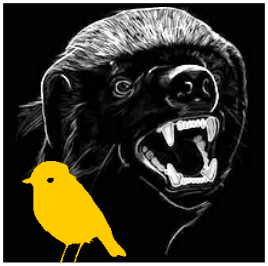Yellowred may be a funny colour, but its denial by mammalogists is even funnier.

Prof. Mumblebard claims: “It is understandable that extremely few mammal species are called orange in vernacular or scientific English. Firstly, owing to its Sanskrit origins, ‘orange’ has not been fully assimilated into scientific English. After all, this is an unusual word for a colour, being both an adjective and a noun in describing the eponymous citrus fruit. Secondly, the word ‘orange’ and the associated citrus fruit only reached England relatively recently from southern Asia. And lastly, the brightest-hued of brownish animals are best described as ‘chestnut’, ‘rufous’, ‘rusty’, ‘golden’, or ‘ochraceous’, terms which are more accurate and precise than ‘orange’.”
Robin and the Honey Badger respond: “Anglophone scientists have not been accurate, precise, objective or consistent in describing and naming orangeish-brown or brownish-orange species of animals. The use of ‘red’ and ‘reddish’ in both vernacular names and formal descriptions of mammals and birds is – despite its long-standing tradition in biology – incorrect where the hue referred to is demonstrably orange. Terms such as ‘chestnut’, ‘rufous’, ‘rusty’, ‘golden’, and ‘ochraceous’, even if used consistently, are no more scientific than ‘orange’, which unambiguously refers to a narrow range of electromagnetic wavelengths. And the historical reasons given for these inaccuracies are not true, either rationally or factually. Firstly, the logical link between colour and citrus fruits is weak because other examples of orange, such as autumn foliage, have always connected Britain, through Europe and western Asia, to southeast Asia. Secondly, English has never lacked a term for this colour, because the Old English yellowred was originally available to describe animals called red inaccurately, e.g. red squirrel, red fox, and red deer. Thirdly, the colour orange did not correspond historically with the eponymous fruit. Orange citrus reached Britain as long ago as 1066, when Old English was unrecognisably different from present-day English, whereas the first record of the word ‘orange’ is from 1512, around the time when Modern English first arose. Fourthly, Modern English – including the word ‘orange’ – has been written for half a millennium, ample time for this colour to be applied to organisms. The real reasons for the anglophone bias against orange are cultural and subconsciously emotional, and therefore unscientific. Whereas the most widespread Eastern traditions, e.g. Confucian, Buddhist and Hindu, have recognised, celebrated and even venerated this colour for thousands of years, most European traditions have tended to dismiss orange as frivolous despite taking red seriously. The anglophone tendency to overlook orange persists to this day in biology, at the expense of scientific rigour.”

Please join us here at the Bio-edge with your own comments. In the discussion below we encourage links to any evidence supporting either Prof. Mumblebard or Robin and the Honey Badger. Illustrations are welcome but please cite all sources or we may be forced under copyright to delete your comment.
***
Featured image: A golden (nay, orange!) lion tamarin family by Steve (CC BY-SA 2.0, Tamarin Family)

